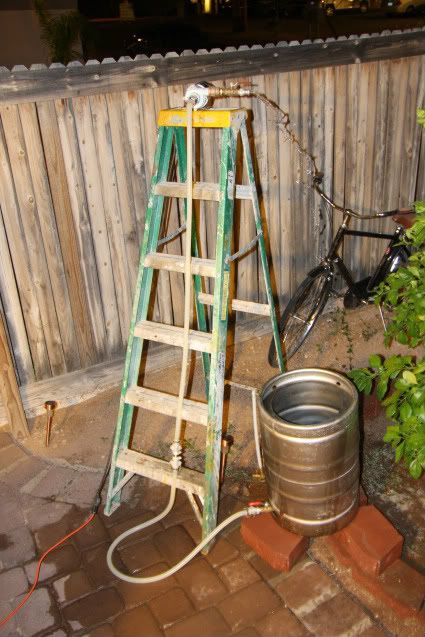What kind of pump are we talking here? The 10 psi of suction head mentioned earlier is clearly an exaggeration and in the realm of vacuum pumps. It's simply out of the question for centrifugal pumps.
I think the 10 psi mentioned was a rough guess by Cat22. He later said that he thought his LG pump actually produced just under 7psi, which IMO is probably pretty accurate.
We can also rule out cavitation. Lautering water at 170^F boils at 8.7 psi of vacuum. That's 20 feet of suction head at the pump inlet, also out of the realm of possibility for centrifugal pumps.
So what's left? It's easy enough to measure the suction head for your pump. Set a kettle filled with water so the starting water level is a few inches above the pump inlet, and the drain leading to the pump is below the pump inlet. This should be enough to prime the pump and get a good stream coming from the pump. Start the pump. When it stops pumping, close the drain valve to prevent back flow, and stop the pump. Measure the height of the water level above or below the pump inlet.
Measured in inches, this is the inches of water column of pump inlet suction head, less losses in the line and fittings. 27" of water column is equal to 1 psi. Calculate the psi, and apply this over the area of your FB. The resulting force in pounds is the maximum you can attribute to pump suction.
Write back and let us know what you measure. We'll all have learned something then. (I'm expecting a range from slightly above, due to line losses, to a couple of inches at most below. I'm willing to be surprised, however, since I haven't done this experiment. No pumps in this brewery, so I'll wait to hear your results.)
My fluid dynamics knowledge is rudimentary at best, so I’m probably the wrong person to explain this, but here goes anyway.
As Catt22 already mentioned, the vacuum a pump pulls is going to be approximately equal to the output pressure, which is easily found by looking at the pumps max head. The vacuum head pressure has to equal the output head pressure in order for the pump to move any fluid. Think of it this way, if a pump were only able to create a few inches WC of vacuum, then how would it feed itself enough to create several feet of head pressure on the output side? Depending on the model, march 809hs pumps have between 12.1' and 15.5' max head, which converted from WC equals 5.2-6.7psi. My LG pump has a max head of 18', or 7.8psi. These figures are calculated in an ideal setting, so real world figures will most likely be less, but not by much.
Since I’m guessing this explanation won’t be satisfactory for many people, I set up a test similar to what you suggested. Since I knew the pump would pull significantly more than the few inches you estimated, I filled a keggle with water and set it on the ground, set a ladder next to it, cobbled two transfer hoses together, and connected them to the drain and a pump. I then primed the pump on the ground, and climbed the ladder with the pump in hand. The flow of water exiting the pump only decreased slightly even when I raised it as far as the hoses would allow, which was about 9’ (two 5' hoses with 6" slack on either end to prevent kinking). I set the pump on top of the ladder to get a pic, and without me holding it the weight of the hoses and fittings caused a kink in the hose at the pump inlet, slowing the flow considerably. Even with a kink in the hose, a stream of water exiting the pump is still clearly visible. The suction is obviously more than the 9’ I was able to test, since I was able to drain the keggle completely at this height. In order to test the maximum vacuum head of my pump I’d need longer transfer hoses and a taller ladder. I don't really feel inclined to test any further though, since I already know the result would be close to 18'.

The real question isn't how much a pump can pull but why would you want to pull that much pressure in the first place? how would that ever be beneficial to the brew?...or the equipment in this case.
I don't think anyone is saying that they are trying to create a lot of pressure intentionally, we're saying that these pressures can easily happen in a brewing scenario. In the case of the OP it's happening quite unintentionally, and much to his dismay since it's damaging his false bottoms.
Here's the March 809 manual with rudimentary pump curves:
http://www.marchpump.com/site/files/966/112170/382390/523930/Pump_Manual.pdf
For what it's worth, it seems to me improbable that the tiny motors and magnet drive to pull significant suction pressure of the magnitudes we talked about. But, again, I'm willing to be surprised by actual measurements.
That manual and set of curves is for a very weak pump that I've never seen used for brewing. It only produces 4.3' of max head, which IMO is way underpowered for brewing applications. The march 809
hs commonly used for brewing produces nearly three times as much head pressure.












































![Craft A Brew - Safale S-04 Dry Yeast - Fermentis - English Ale Dry Yeast - For English and American Ales and Hard Apple Ciders - Ingredients for Home Brewing - Beer Making Supplies - [1 Pack]](https://m.media-amazon.com/images/I/41fVGNh6JfL._SL500_.jpg)



















